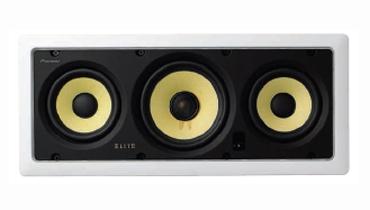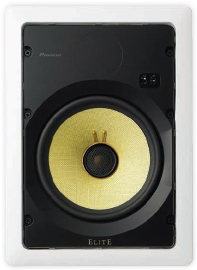Pioneer Elite S-IW571L, S-IW871LR

| Key Features |
| $2,996 (as tested) PIONEERELECTRONICS.COM |
| S-IW571L • (2) 51?4-in woofers • 61?2-in midrange/woofer • 11?2-in tweeter; 2011?16 in wide • 13 lb S-IW871LR • 11?2-in tweeter • 1315?16-in high • 7 lb |
There are few concepts in manufacturing more hallowed than the "skunk works," a design group that operates outside the mainstream of the corporation that employs them. The name was coined to describe a Lockheed facility in Palmdale, California that has produced some of the world's most extraordinary jet aircraft. Only 80 miles away, in the nondescript suburb of Pomona, another skunk works has been flourishing for more than a decade. In this backwater of Pioneer's worldwide operations, surrounded by shelves of raw drivers and carcasses of past prototypes, Pioneer chief speaker designer Andrew Jones and his crew have designed everything from $40-per-pair minispeakers to the $60,000-per-pair TAD Reference One towers.
Jones's team has recently focused on architectural speakers - i.e., in-wall and in-ceiling models. Extra effort went into the models designed for Pioneer's high-end Elite line, which are intended to compete with the world's most storied speaker brands.
The Pioneer Elite architectural speakers are notable for their concentric drivers, which use 1½ -inch titanium tweeters mounted in the center of various woofers. Pioneer refers to its concentric designs by the acronym CST, for Coherent Source Transducer.
The advantage of a concentric arrangement is that two drivers share the same physical location. When a woofer and tweeter are separated, as they are in a conventional twoway speaker, the two drivers' sound waves interfere with each other, reinforcing certain frequencies and therefore canceling others. The effect worsens when you move closer to one driver, such as when you listen standing up.
With concentric drivers, it's physically impossible to move closer to the woofer or the tweeter because both occupy the same space. Thus, the speaker's sound will vary only subtly as you move around the room. The downside of concentric drivers is that the woofer cone can narrow the tweeter's dispersion and color its sound. As proven in the TAD Reference One and designs from Thiel Audio and others, though, careful engineering can lessen or even eliminate this problem.
Of the latest Elite in-walls, I was most curious about the S-IW571L, an LCR-type speaker designed primarily for use in the front left, center, and right channels of a surround sound system. The S-IW571L is unusual in that its midrange driver - the 6½-inch aramid fiber cone that surrounds the 1½-inch titanium dome tweeter - is larger than the speaker's dual 5¼ -inch woofers.
The S-IW571L will work fine for surround channels, too, but to add some variety I asked Pioneer to supply a pair of S-IW871LR speakers for the surrounds. The S-IW871LR looks as if Pioneer's engineers forgot to give it a tweeter, but of course the tweeter's sitting right there in the middle of the 8-inch woofer. Both Elite speakers feature a cast aluminum baffle holding the drivers. This baffle is much more substantial than the molded plastic ones used in most in-walls. The more massive the baffle, the better it prevents the drywall panels around the speaker from vibrating. Stray vibrations in the drywall are the primary contaminant of in-wall speaker sound - and one reason in-walls still suffer a poor reputation with many audiophiles.
| SETUP These speakers install like most other in-walls: Plastic "doglegs" flip out to clamp the speaker bezel against the drywall surrounding it. The concentric drivers give the Elites an advantage in installation, though - your installer can mount them vertically or horizontally, and they'll sound much the same either way. This isn't true of conventional in-walls, with a tweeter mounted above a woofer. Some installers make the mistake of flipping such speakers on their sides for the sake of looks or convenience, but this practice often results in radical changes in timbre as you move from one end of the couch to the other (and closer to either the woofer or the tweeter). The one decision you have to make with these speakers is the setting of the treble level switch, which has positions for - (cut), 0 (flat), and + (boost). But unless you're putting them in a room with no absorptive material at all - not even a carpet - I strongly recommend the + setting. The S-IW871L also has a bass cut switch that can help in fine-tuning the low frequencies. I first tried both the S-IW571L and the S-IW871LR as stereo speakers without a subwoofer. I then used them to create a home theater system with three S-IW571Ls up front and the two S-IW871LRs as surrounds; I alternated between Sunfire TS-SJ8 and Proficient Audio PS12 subwoofers. |
The S-IW871LR in-walls (above) feature an 8-inch woofer for big in-wall bass, along with treble level and bass cut switches to fine-tune the highs and lows. |
|---|














































